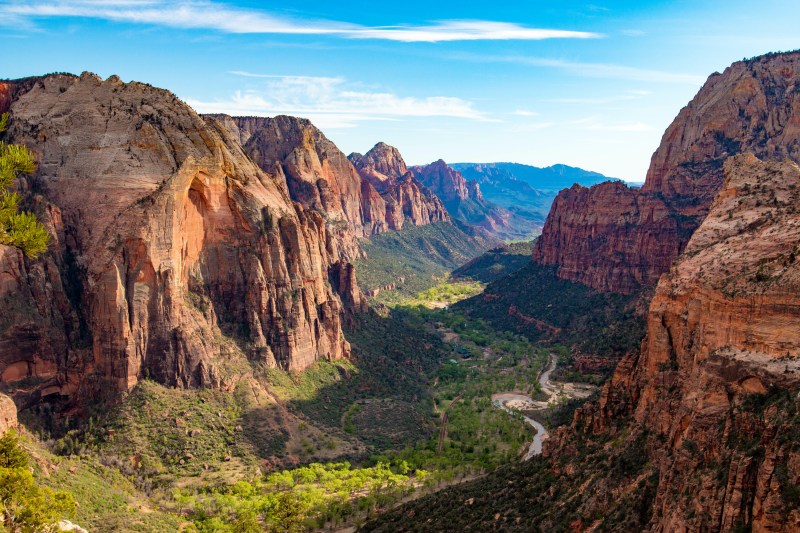America’s national parks hold so much adventure, and visiting them gives you the opportunity to connect with the country’s most breathtaking natural landscapes. From the towering peaks of the Rocky Mountains to the peaceful coastlines of the Atlantic, these parks showcase diverse ecosystems, stunning views, and a deep sense of peace for the weary soul. Each one offers visitors something special, from scenic drives to thrilling hikes. Without further ado, here are the most beautiful U.S. national parks and why you should visit before the year ends.
1. Crater Lake National Park, Oregon

Known for its stunning deep blue water, Crater Lake National Park tops our list. It’s believed that this gorgeous lake was the result of an ancient volcanic eruption that left a caldera, which later filled with clear rainwater and snow. It is the deepest lake in the U.S., and its clarity and color make it a dramatic sight.
Things to do:
- Crater Rim Drive: Take the 33-mile scenic drive around the rim of the lake, which offers various panoramic views.
- Cleetwood Cove Trail: This is the only trail that provides access to the lake’s edge. You can swim or take a boat tour to Wizard Island, a volcanic cinder cone that rises out of the lake.
- Hiking: Trails range from easy walks to challenging hikes. For a leisurely walk, try the Sun Notch Trail, which takes you through meadows, forests, and a view of Phantom Ship. Try the Mount Scott Trail for something more adventurous. This will take you to the highest point in the park.
- Winter Activities: Snowshoeing and cross-country skiing are popular in the winter months since the park receives heavy snowfall.
Entry fee
$30 per vehicle during summer, $20 during winter (valid for 7 days).
2. Acadia National Park, Maine

All the way on the other coast lies Acadia National Park, which is known for its rugged coastlines and stunning views of the Atlantic Ocean. It’s no surprise that this is considered to be one of the most beautiful U.S. national parks in the country. The ecosystem here is very diverse, from forests to rocky headlands, and there’s always going to be something interesting to see. Acadia National Park is particularly well-known for its gorgeous fall foliage.
Things to Do:
- Cadillac Mountain: This mountain is the highest peak on the eastern seaboard, and it is famous for its breathtaking sunrises. Since it’s accessible by car, you can drive to the summit. Or, consider one of the numerous hiking trails.
- Park Loop Road: This is a scenic 27-mile road that takes you through some of the park’s most famous sites, like Thunder Hole and Sand Beach.
- Hiking: For an easy hike, try the Jordan Pond Path, which will take you around a pond and show views of the Bubbles Mountains. For something more challenging, try the Precipice Trail, which is 2.5 miles round-trip that features steep climbs up Chaplain Mountain with iron rungs bolted into the cliff.
Entry Fee:
$35 per vehicle for 7 days.
3. Glacier National Park, Montana

Glacier National Park, located in the northern Rocky Mountains of Montana, is often referred to as the “Crown of the Continent” because of how amazing it is. When you visit this national park, be prepared for sparkling alpine lakes, dense forests, and, of course, icy glaciers! Glacier National Park spans over one million acres and extends to the Canadian border, where it joins Waterton Lakes National Park. In the center, they form the Waterton-Glacier International Peace Park, a UNESCO World Heritage Site that’s recognized for its unique natural beauty and cultural significance.
Things to Do:
- Going-to-the-Sun Road: This is a breathtaking 50-mile drive through the heart of the park. It’s one of the most scenic roads in the world and is a must-see.
- Hiking: There are over 700 miles of trails. Popular hikes include the Grinnell Glacier Trail and Highline Trail.
- Boat Tours: For a different sort of adventure, take a boat tour on one of the park’s glacial lakes, like Lake McDonald or St. Mary Lake.
- Wildlife Watching: Since the area has over 70 species of mammals, keep an eye out for mountain goats, grizzly bears, and moose.
Entry Fee:
$35 per vehicle for 7 days in the summer, $25 in the winter.
4. Shenandoah National Park, Virginia

Shenandoah National Park, located in the Blue Ridge Mountains of Virginia, is known for its 200,000 acres of rolling hills, expansive forests, and fall foliage. It’s an excellent escape for those looking to enjoy the Appalachian wilderness without venturing too far from major cities.
Things to Do:
- Skyline Drive: This scenic drive is 105-miles long and runs the length of the park. Try to catch this one during the fall season, and you won’t regret it!
- Hiking: The park features over 500 miles of trails. Highlights include Old Rag Mountain for the experienced hiker and Dark Hollow Falls Trail for a shorter, scenic hike to a waterfall.
- Appalachian Trail: If you want to try hiking a portion of the Appalachian Trail, Shenandoah National Park is a great place to try. 101 miles of this famous trail runs through the park.
- Stargazing: With relatively little light pollution, Shenandoah offers great stargazing opportunities on clear nights. Try heading to Big Meadows, which offers unobstructed views of the night sky with minimal light pollution.
Entry Fee:
$30 per vehicle for 7 days.
5. Zion National Park, Utah

Another fantastic park to add to your list is Zion National Park in Utah. This park is famous for its rich history, which was shaped by geological forces, Native American cultures, and early settlers. Zion is renowned for its towering red cliffs, deep canyons, and stunning desert landscapes. It offers everything from easy riverside strolls to heart-pounding cliffside trails.
Things to Do:
- The Narrows: This hike takes you through the Virgin River, where you can wade between towering canyon walls.
- Angel’s Landing: For something a bit more difficult, try Angel’s Landing. It’s an incredibly steep trail, but it rewards hikers with a 360-degree view of Zion Canyon from the summit.
- Zion Canyon Scenic Drive: This is the most iconic drive in Zion and takes you through the heart of Zion Canyon, surrounded by towering red and pink sandstone cliffs. It stops at several key locations like the Court of the Patriarchs and The Grotto.
Entry Fee:
$35 per vehicle for 7 days.
From sea to shining sea, each of these national parks has something special to offer. Whether you’re looking for a relaxing getaway or an adrenaline-filled thrill, you’ll be able to find something to satisfy your soul.




